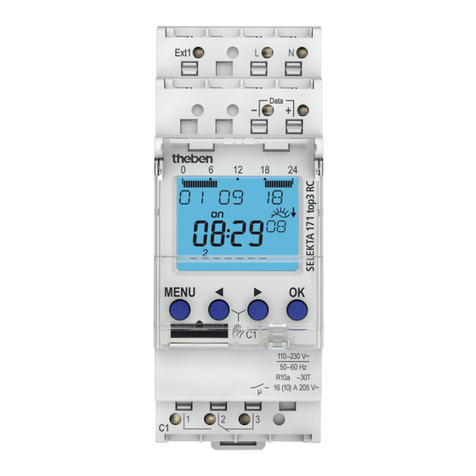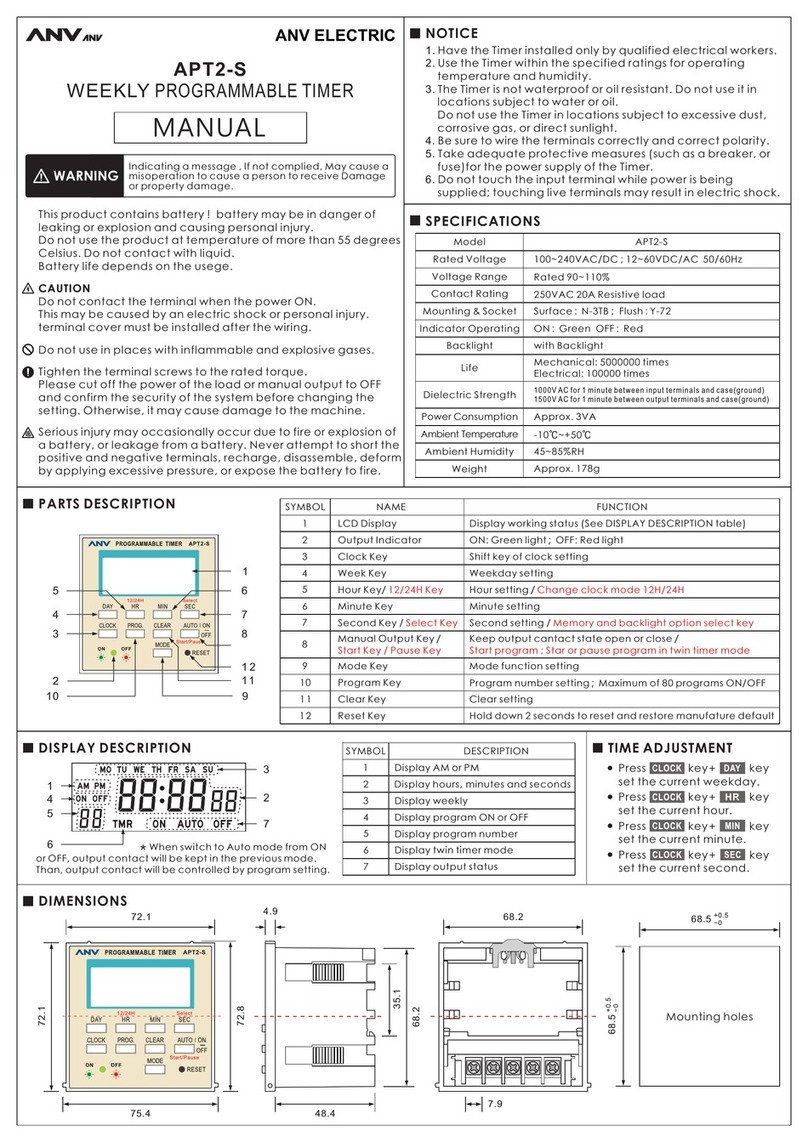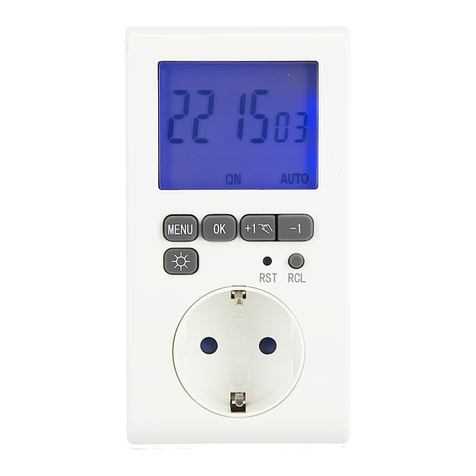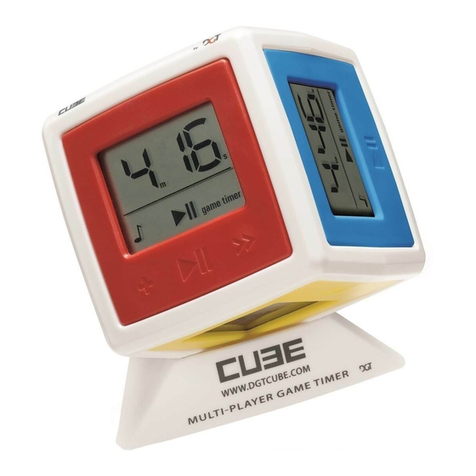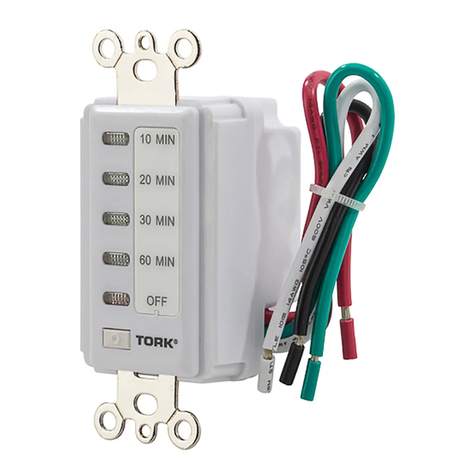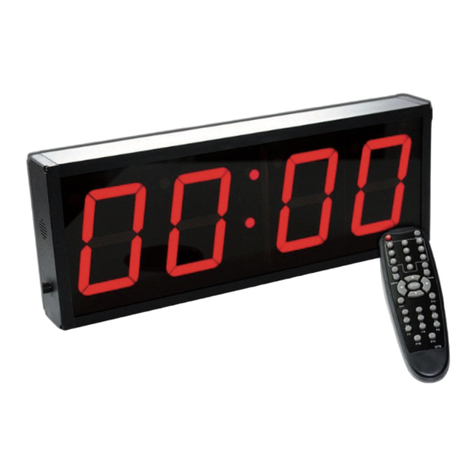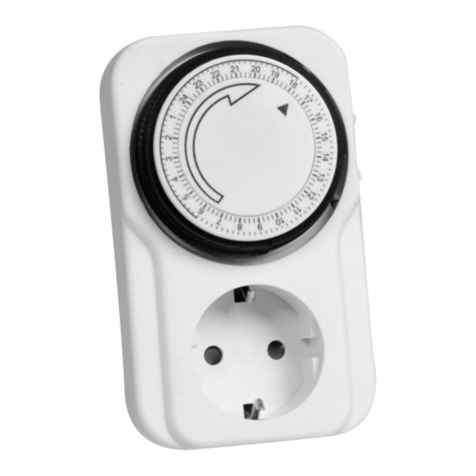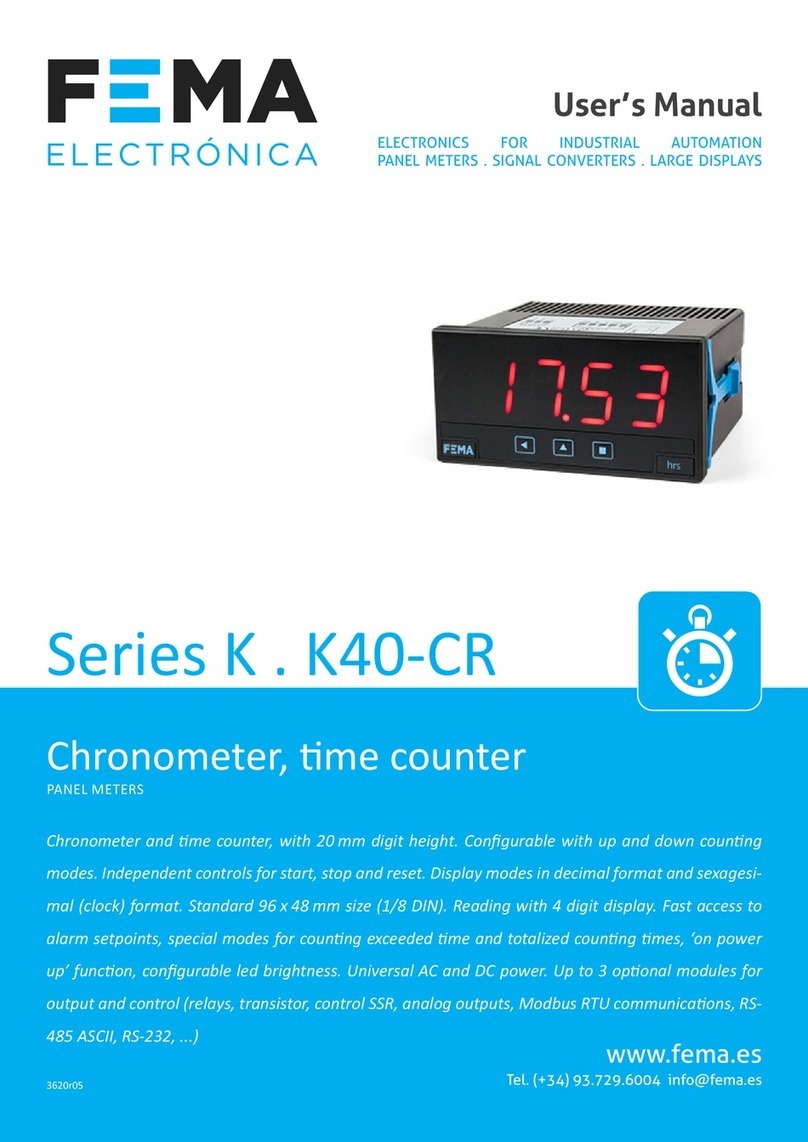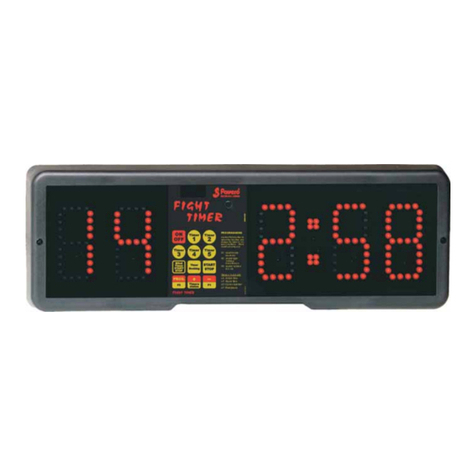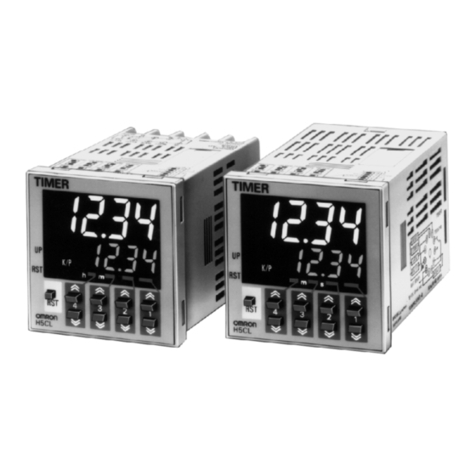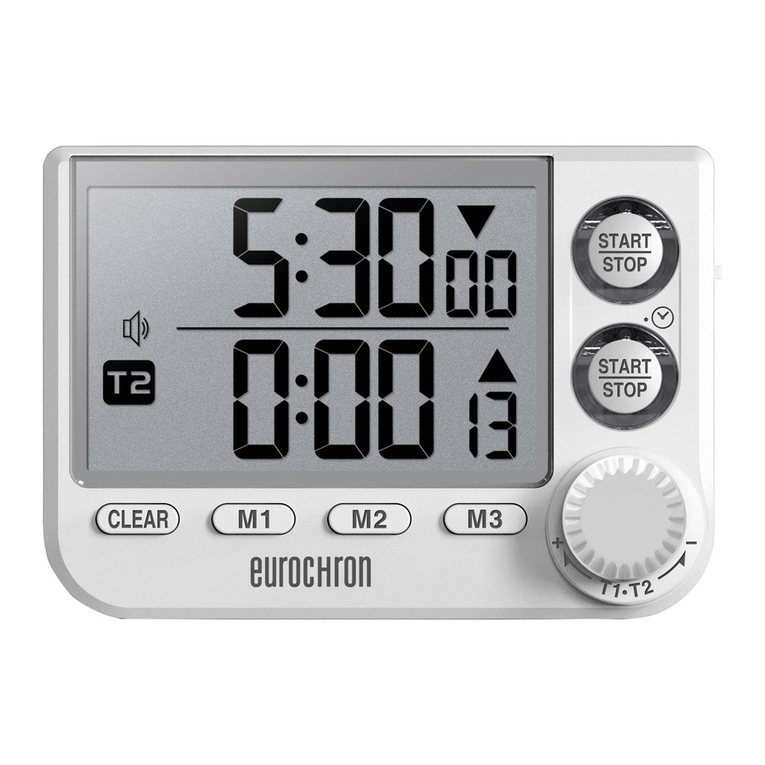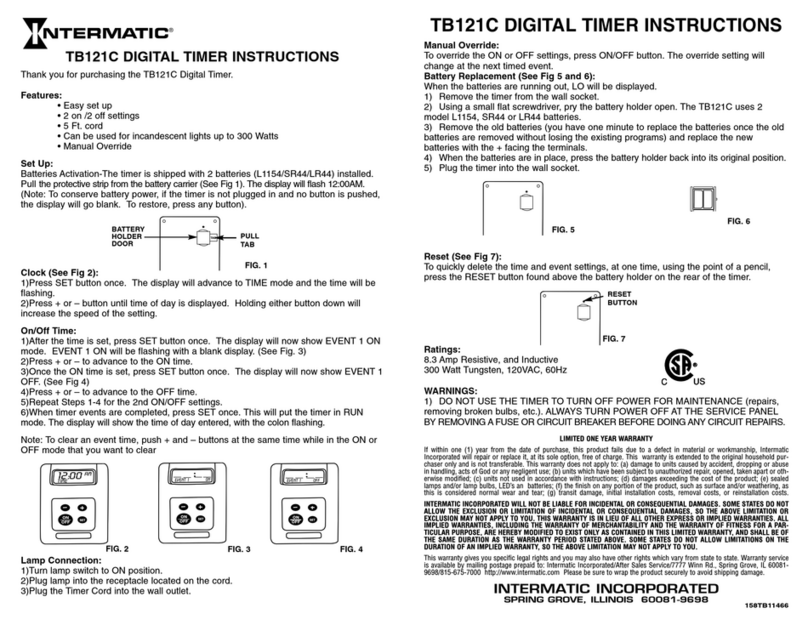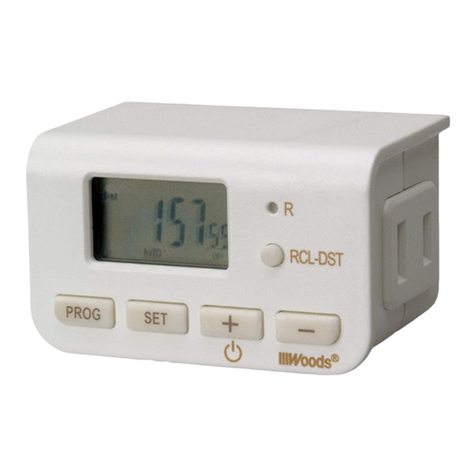Berker 7521 20 06 User manual

1 Programming / checking mode
2 Button for setting current time
3 Button for setting day of the week
4 Days of the week
(1 = Mon, 2 = Tues, 7 = un)
5 Cursor for displaying days of the week
6 Hour display
7 Display for automatic summer/winter time
(adjustment (r= summer / f= winter)
8 Bus-connection
9 Minute display
10 witching status display ON ( o) OFF ( p) channel K1
11 witching status display ON ( o) OFF ( p) channel K2
12 Hour setting
13 Minute setting
14 General deletion (RE ET)
Attention: this button deletes all stored data!
15 Channel K2
16 Channel K1
20
7521 20 06
2
3
4
5
7
6
9
8
10
11
12
13
14
15
116
Res
12345671234567
dh
m
K1
Prog K1 K2
K2
GB

1.0 escription
1.1 Use
1.2 Features
1.3 Technical data
1.4 Dimensioned diagram
2.0 Mounting instructions
2.1 afety information
2.2 Bus-connection
3.0 Start-up
3.1 Information
3.2 Advices
3.3 Automatic reset
3.4 Fast forward
3.5 witching-preselection
3.6 Automatic-mode
3.7 Priorities
3.8 Identification of automatic summer/winter time adjustment
4.0 Programming
4.1 Programming in the week program
4.2 Programming in day program
4.3 Interrogation program
4.4 Change program
4.5 Individual deletions
4.6 General deletion of all switching times
4.7 General deletion (RE ET)
5.0 Switching functions
5.1 Override ON/OFF telegram
5.2 Permanent ON/OFF telegram
5.3 Holiday program
5.4 Breaking off the holiday program
6.0 Summer/winter time adjustment
6.1 election table for the automatic summer/winter
time adjustment
6.2 Changing the automatic summer-/wintertime
adjustment
6.3 Initial start-up without automatic summer/winter
time adjustment
6.4 Initial start-up with automatic summer/ winter
time adjustment
6.5 Manual summer/winter time adjustment
21

The time switch controls connected nodes via the group address.
The time switch sends 1- or 8-bit telegrams, as required.
The time switch is pre-programmed with date, automa-
tic summer / winter time change-over and real time as a
weekly clock.
– permanent program retention by means of EEPROM.
programmed switching times are retained for a period of
approx. 10 years even in the event of a power failure or insuffi-
cient battery reserve.
– automatic program recall
– 99 days holiday program, programmable 99 days ahead
– over-ride switching
– permanent switching ON / OFF
– battery reserve by means of lithium cell, approx. 6 years
1.0 ESCRIPTION
1.1 Use
1.2 Features
22

esignation: 7521 20 06
Type of program: Day or week
Operating voltage: Bus-connection
Interval consumption: ca. 150mW incl. BCU
Time base: Quartz
Memory locations: 36
Min. switching interval: 1 minute
witching accuracy: To the second
Operating accuracy: ± 1 sec./day at 20° C deg. C
Power reserve: Lithium, max. 6 years at
20° C deg. C
Perm. ambient temp.: – 5° C ... + 45° C (– 5T45)
Class of protection: II acc. to EN 60335
when mounted
ystem of protection: IP 20 acc. to EN 60529
Technical data on device nameplate may vary - please check!
ubject to technical alterations.
1.3 Technical data:
EMC-Advice
1.4 imensioned drawing:
23
The time switches are in accordance with the European directives
73/23/EEC (Low-Voltage Directive) and 89 / 336 / EEC (EMC-
Directive). If the time switches are used together with other devices
in an installation, take care that the complete installation does not
cause a radio interference.

Electrical devices EIB should only be connected and
mounted by an EIB specialist. Manipulations and modi-
fications will result in loss of warranty. The
national specifactions and applicable safety regulations
must be observed.
Despite elaborate safety precautions, exceptionally strong
electrical fields may cause interference with the microprocessor-
controlled time switch. We therefore recommend that you observe
the following points before installation:
➪ uppress interference of inductive loads by means of an
RC filter
➪ Use a separate line for the mains voltage supply
➪ Do not install device in close proximity to sources of interferen-
ce, e.g. transformers, contactors, PCs and TV sets.
➪ If interference occurs, we recommed that you carry out a RE ET
(chapter 4.7) before putting the device back into operation
2.0 MOUNTING INSTRUCTIONS
2.1 Safety information:
2.2 Bus-connection:
24

3.0 Start-up
The device comes ready programmed with the current
time and with the relevant Greenwich mean time rule
for automatic summer-/winter time adjustment.
Changing of time adjustment see chapter 6.0.
3.2 Advices
3.3 Automatic reset
3.4 Fast forward
3.5 Switching-preselection
This symbol means: Important! Please note!
This symbol means:
You must press the button illustrated for
programming.
Example: n= Press the button with the clock
symbol.
If no buttons are pressed for a certain length of time in the
checking or programming mode, the display is autmatically reset to
automatic mode after approx. 40 sec. The device then assumes the
switching status dictated by the program.
When setting the time or programming, the fast forward function
is obtained by holding down button hor mfor more than 4 sec.
The o-symbol indicates that the allocated consumer receives, for
example, an ON telegram, according to parameters.
The p-symbol indicates that the allocated consumer receives, for
example, an OFF telegram, according to parameters.
25
3.1 Information

3.6 Automatic-mode
You see in the automatic mode:
- actual time
- summer-/winter time adjustment is activated
- load sends ON or OFF-telegram
- load sends permanent ON/OFF telegrams
- Holidayprogram is activated
Changing to automatic mode
press button n
3.7 Priorities
3.8 Identification of automatic summer/ winter time
adjustment
rummer time symbol fWinter time symbol
26
AA permanent switch setting takes priority over all other programs
BA holiday program takes priority over a switching preselection
or the automatic program
CManual switching changes the switching status until the
next contrary switching command
If the switch-on and switch-off time are identical, the
switch-off time always takes priority

The time switch is able for:
- individual programming of the weekdays
- free blockforming
This means that identical switching times valid for
several days of the week only occupy one memory
location.
Example of a switch- on time:
The connected consumer is to switch in channel K1 on ( o) at
6:30 on Monday (1), Tuesday (2), Wednesday (3) and Friday (5).
4.0 PROGRAMMING
4.1 Programming in the week program
1)
9) 10)
d
1234567
Prog
1234567
d
1234567
4)
Prog
1234567
5)
d
1234567
6)
d
1234567
7)
Prog
1234567
8)
m
1234567
Prog
1234567
Prog
1234567
2)
11) 12)
13)
1234567
C1
Prog
1234567
3)
h
1234567
K1
K2
K1
K2
27
ON
K1

Example of a switch- off time:
The connected consumer is to switch off ( p) at 8:30 on Monday
(1), Tuesday (2), Wednesday (3) and Friday (5).
1)
1234567
2X C1
d
1234567
7)
d
1234567
3) Prog
1234567
4)
d
1234567
5) Prog
1234567
6)
Prog
1234567
2)
8) d
1234567
9) Prog
1234567
10) h
1234567
m
1234567
11)
Prog
1234567
12)
1234567
13)
Automatik
Aus
K1
K1
K1
K2
K2
Note:
Further switch times can be programmed as before.
For programming channel 2, use the button K2.
When all 36 memory locations are full, the word End appears
in the LCD display.
If a switch-on and switch-off time are programmed simulta-
neously, the switch off time will always take priority.
28
OFF

Time-sensor only for dayprogram:
Restart of the time-sensor like in chapter 6.3/6.4 described.
Example: Channel K1 switch-On (o) at 6.30 hours and
switch-Off again at 8:30 hours (p).
4.2 Programming in the day mode
3) 4)
8)
7)
9)
hm
hm
Prog
1) Prog 2) C1
5) Prog 6) 2X C1
10)
K1
K2
K1
K2
K1
K2 K1
K2
K1
K1
K2
With button K1 a choice can be made, while programming,
whether a switch on (symbol o) or a switch off (symbol p)
should be effected.
For programming channel 2, use the button K2.
29
K1

3)
Prog
1234567
1)
1234567
Prog
2)
1234567
K1
K2
K1
K2
K1
K2
Illustration 1: in channel K1 switch on ( o) is effectd Mo, Tues,
Wed, Fri at 6:30 hours
Illustration 2: in channel K1 switch off ( p) is effected Mo,Tues,
We, Fri at 8:30 hours
4.3 Program interrogation
4.4 Program change
5)
Prog
1234567
1)
1234567
2) h
1234567
1234567
3) mProg
4)
1234567
K1
K2
K1
K2
K1
K2
K1
K2
K1
K2
Illustration:
Picture 1: Mo, tue, wed, fri at 6.30 hours switch-on in K1
Picture 2 + 3: change Mo, tue, wed, fri at 9.45 hours switch-off
Change block-formation:
Press button d several times with only one cursor is still
blinking.
Place cursor above desired weekday
tore by pressing button Prog.
30

Use PROG to search switching time bo be deleted.
Only the displayed switching time will be deleted.
Press buttons h and m simultaneously.
4.5 Individual deletions
1) 2)
3)
1234567
1234567
1234567
K1
K2
K1
K2
K1
K2
Attention!
This action deletes all stored switching times.
(The current time and the selected time adjustment rule
remain).
General deletions off all switching-times
Press the button Prog
Press buttons d + h + m simultaneously
Now you are able to:
- program
- change to automatic mode with button n
4.6 General deletion of all switching times
4.7 GENERAL ELETION (RESET)
eletion of all stored data:
Press button Res. without operation voltage.
eletion of summer-/winter time adjustment and the
current time:
The stored program is retaines.
Press button Res. with operating voltage.
31

5.0 SWITCHING FUNCTIONS
5.1 Override ON / OFF telegram
Effect:
During automatic operation, by pressing button K1 or K2 to the
connected electrical unit can be slut an on ( o) or off ( p) or
8-Bit Telegramm.
When button K1 or K2 has been pressed, the time switch accepts
the desired switching condition.An over-ride switching is corrected
by the next contradictory switching command.
K2 K1
K2
K1
K2
K2
55
5.2 Permanent ON / OFF telegram
Cancelation of permanent switching:
First hold button m.
Press button K1 or K2 until the dat disappears.
After cancellation of a permanent switching the time
switch effects a program recall. This results in the time
switch checking the stored program and implementing
the correct switching condition.
permanent ON permanent OFF
automatic
32

5.3 Holiday program
Effect:
The selectable holiday program makes it possible to interrupt the
stored program for a max. 99 days.
(Both channels switch condition off = p).
The programming of the holiday program can be effected up to a
max. 99 days ahead. The beginning and end of the holiday is, in
each case, at midnight. The present day is not included.
Example: On Monday a holiday program is activated, which is
effective from Friday for a period of 2 days. For the
period of setting, the button h must be held down!
If the holiday program is to be broken off, the display of
the holiday program must be set back to 00 00 with the
buttons d, h, m, as described above.
The symbol hgoes out.
After cancellation of a permanent switching the time
switch effects a program recall. This results in the time
switch checking the stored program and implementing
the correct switching condition.
5.4 Breaking off the holiday program
33

34
6.0 SUMMER-/WINTERTIME A JUSTMENT
The time switch is able to carry out the summer/winter time
adjustment automatically.
On initial operation you must select from the following table
the applicable time adjustment for your country.
Example: for Germany dat 1.
6.1 Selection table for automatic summer/
winter time adjustment
6.2 Changing the automatic summer-/winter time
adjustment
First press nand then button d.
Hold down both buttons for approx 2 secs.
The set summer-/winter time adjustment rule will then appear in
the LCD display (e.g. dat1).
Press button K1 to change the adjustment rule.
tore with button Prog.
Change the year with button d.
tore with button Prog.
Change the current day with button d.
Change the month with button m.
tore with Prog.
Set-
Beginning of Beginning of Appl.
ting area
summer time winter time bereich
dat up Last un. Last un. EU
to 12/95 in March in ept.
dat 1 Last un. Last un. EU
from 1/96 in March 2:00➔3:00 in Oct. 3:00➔2:00
dat 2 Last un. 4th week Only for Uk up to 1997
in March 1:00➔2:00 in Oct. 2:00➔1:00
dat 3 1st. un. Last un. North
in April 2:00➔3:00 in Oct. 3:00➔2:00
no No No
adjustment adjustment

When the button nis released after entering the time, both dots
between the hour and minute display should flash. If not, repeat
the setting.
35
6.3 Initial start-up w i t h o u t automatic summer/
winter time adjustment
Weekprogram:
see 2: The button K1 can be used to set the required time
adjustment rule from the table in Chapter 6.1.
see 4): Button dcan be used to set the current day of the
week (1 = Monday, 2 = Tuesday,..7 = unday).
ayprogram:
see 4): Don’t use button d.
1)
2) 3X
RES
K1
Prog
m
1234567
5xd5 x d
5
5
5
h
3)
4)
5) 6)
7)
K1
K2
2
time adjustment
z. B. 3 = minutes
days
automatic
K1
K2

When the button nis released after entering the time, both dots
between the hour and minute display should flash. If not, repeat
the setting.
36
6.4 Initial start-up w i t h automatic summer/winter
time adjustment
Weekprogram:
see 2): The button K1 can be used to set the required time
adjustment rule from the table in chapter 6.1.
see 9): Button d can be used to set the current day of the
week (1 = Monday, 2 = Tuesday, ... 7 = unday)
ayprogram:
see 9): Don’t use button d.
55
5
5
Res
d
Prog
K1
d
Prog
m
Prog
1)
3)
2)
4)
5) 6)
7) 8)
9)
10) 11)
h
mK1
K2
2
d
9)
9) 10)
11) 12) K1
K2

6.5 Manual summer/winter time adjustment
If no automatic adjustment has been selected, the time can
be corrected manually +/– 1 hour.
First hold button d.
Change with h or m the current hours.
h
d+1h
1234567
-1h
m
d
1234567
K1
K2
K1
K2
37
Table of contents
Other Berker Timer manuals

